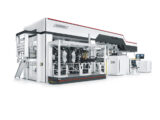With a solid order backlog of more than €630m Koenig & Bauer expects to achieve organic revenue growth of around 4% and break even at the EBIT level in 2021
March 24, 2021The Koenig & Bauer Group (“Koenig & Bauer”) achieved revenue of €1.0bn in 2020 (2019: €1.2bn) despite the challenges posed by the Covid-19 pandemic. The 17.4% decline in revenue reflects the measures adopted by governments worldwide in 2020 to halt the spread of the Covid-19 pandemic. Travel restrictions in particular hampered international sales activities as well as order and project execution. Service business accounted for about 30% of the Group’s revenue in 2020 against the backdrop of the pandemic. This means that the target of 30% was reached, albeit on the basis of lower new press business than in the previous year. The 14.6% decline in order intake to €975m (2019: €1.1bn) is also due to Covid-19-related constraints on global economic activity and customers’ reluctance to invest in view of reduced forward planning visibility.
However, the decline in Koenig & Bauer’s revenue and order intake in 2020 was much less pronounced than for the printing press industry as a whole (24.2% decline in revenue; 21.9% decline in order intake) according to figures released by industry association VDMA (German Machinery and Plant Manufacturers’ Association). Koenig & Bauer’s order backlog as of 31 December 2020 was valued at €632m, down 7.9% on the previous year (31 December 2019: €686m).
Earnings before interest and taxes (EBIT) amounted to €-68m in 2020, compared to €70m in the previous year. In addition to the Covid 19-related decline in revenue, EBIT was adversely affected by non-recurring expenses of €58m in connection with the expanded “P24x” efficiency programme announced in autumn 2020. However, non-recurring income from the successful outcome of a legal dispute (€4m) and from the sale of a real estate asset in Frankenthal (€5m) had a positive effect on EBIT. Adjusted for these non-recurring effects, EBIT came to €-19m in 2020. Despite the effects of the pandemic, a clear quarterly recovery emerged in EBIT: after €-17m in the first quarter, operating loss before exceptionals was only in the single digits (€-7m) in the second quarter. In the third quarter it came close to reaching the break-even threshold (€-1m), while in the final quarter a slightly positive EBIT before non-recurring effects of €6m was achieved.
After net interest expense of around €6m (2019: €6m), Koenig & Bauer achieved earnings before taxes (EBIT) of €-73m in 2020, compared with €64m in the previous year. Tax expense came to €30m in 2020 (previous year: €12m). The higher tax expense in the year under review is primarily due to impairments of deferred tax assets on unused tax losses, which were not considered to be recoverable for the purposes of the preparation of a new integrated five-year plan. The Group net loss of €103m (2019: Group net profit of €52m) translates into a loss per share of €6.27 (2019: earnings per share of €3.15).
Dr Andreas Pleßke, Chief Executive Officer of Koenig & Bauer AG, explains: “Looking at order intake, we can see that the Koenig & Bauer Group held up better in the difficult year of 2020 than our industry as a whole. Despite all due caution given the still very uncertain economic conditions, we take this as a sign that we are focusing on the right end and future markets with our range of presses and services. For example, corrugated-board printing could experience a significant boost in the coming years given the growth in e-commerce. Packaging printing for food, cosmetics and pharmaceutical products, for example, is also proving to be an intact and growing market. Koenig & Bauer has expanded its Radebeul facility, turning it into a global customer experience centre to demonstrate the performance of our presses to customers in these sectors as effectively as possible. The customer experience centre presents networked solutions for packaging production featuring innovative printing technology, flatbed and rotary die cutters, folding-box gluers and fully automated material flows. We are convinced that we will strengthen and further expand our market position not only in the area of packaging printing.”
Covid-19 also leaving clear traces on the individual segments
At the level of the individual segments, the Covid 19-related burdens and the provisions recognised for the measures defined in the “P24x” efficiency programme were also clearly evident in the decline in order intake, revenue and EBIT in 2020.
That said, order intake in the Sheetfed segment declined by only a moderate 5.5%. In 2020, this segment achieved growth in medium- and large-format sheetfed offset presses and folding-box gluers, which were primarily ordered by customers in the packaging printing sector. In the fourth quarter, the Sheetfed segment recorded order intake of €178m, thus exceeding the previous year’s figure (Q4 2019: €166m).
In the final quarter of 2020, the Digital & Webfed segment successfully commissioned the first CorruFLEX system for the production of high-quality printed packaging at corrugated cardboard printing company THIMM’s plant in Romania. This means that all three Corru models for direct corrugated-board printing have now been successfully placed on the market.
In the Special segment, Banknote Solutions, Kammann and Coding reported lower order intake in 2020 in view of the effects of the coronavirus pandemic. MetalPrint, on the other hand, recorded an increase in order intake in 2020.
